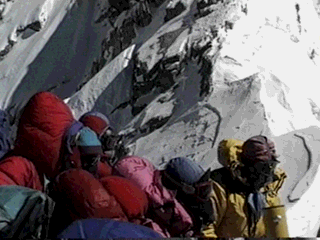
Bernardo Guarachi, 45 years old, has traversed the realms of history by being the first Bolivian to reach the Everest Summit. But from the medical point of view, he has reached, in our opinion, a much higher significance. Bernardo is the best known mountain guide in Bolivia. He has summited Illimani (6490 m), 170 times and of course all the other important mountains in Bolivia and South America including Aconcagua, Chile (6959 m), with no supplementary oxygen. He is a descendant of the Aymaras and has made his conquest as a sole representative of Bolivia, with little funds, joining groups from other countries. On his first attempt back in 1994, he had a normal hematocrit of 56% (average saturation of 92%) for 3510 m, but we noticed that he had small positive slope on the plateau of the single-breath nitrogen washout curve, because of uneven ventilation. On that occasion he did not reach Everest summit, but reached K-2.
Four years later, and four months prior to his second successful attempt on May 25, 1998, he had a hematocrit of 70% and an average saturation of 90%. His many ascents (some even with flu), may have probably injured some alveolar areas of his lung. Life insurance was rejected because of the increased polycythemia. We told him that this polycythemia was a compensating mechanism to his mild pulmonary function alteration, as we sustain in our concept of chronic mountain sickness (CMS), and advised him not to spend a week in Berlin, Germany prior to ascent, as he had planned to attend a ITB gathering there. He could not avoid such compromise, but reduced his stay to two days. Nutrition with proteins and carbohydrates was instructed. The ascent was troublesome. Ironically, he rented 3 tubes of oxygen but once on the mountain, he found out that two were 1/4 full and one only 1/2 full. Plus the Sherpa accompanying him also needed oxygen.
Bernardo eventually went down to rent other tubes and he only used 1 liter/minute (our advice), on his climb from camp 4 to the south summit where he stayed 15 minutes with oxygen and due to lack of climbing equipment was unable to reach the top summit and returned to camp 4. On his way down, at 8500 m he took off the oxygen mask because he noticed that he was hyperventilating too much and felt better. He made a successful reascent with 1 liter per minute initially and raised to 2 liters near the summit on the next try. At the summit (8848 m), he took off his oxygen mask to place the Bolivian flag, and remained without it for about one hour (risky, we now think and it surprised us too), while the other 2 Singapore climbers kept them on. He holds two records (as we have been told) of fast ascent and descent the same day from summit to base camp and permanence without oxygen at the top, where he affirms he "breathed better without the oxygen mask". We don't know the specific type of mask used and we lack an explanation.
For us, Bernardo proves that increased polycythemia was indeed beneficial and an ally in tolerance to extreme hypoxia. It compensated for his mild uneven ventilation. A check-up two days after his return to La Paz, showed that his hematocrit was 62% (probably due to deficient nutrition, fundamentally on rice) and a chest x-rays with some fine nodular spots in both lungs. This observation, we feel is an important contribution to the concept that increased polycythemia, is a compensatory mechanism of adaptation of the organism with anatomical or functional impairment of the lung in a chronically hypoxic environment [1,2]. In the case of Bernardo with minimum impairment but significative increase of the polycythemia, due to the altitude effect. It further sends the message to those suffering from chronic mountain sickness at high altitude, not to fear their increased polycythemia, since it is beneficial for their residence at high altitude, provided their lung and/or heart disease is well taken care of.
Gustavo Zubieta (Jr.) and Gustavo Zubieta (Sr.)
1. Zubieta-Castillo, G. & Zubieta-Calleja G (1996). New concepts on Chronic Mountain Sickness. Acta Andina, Vol 5:1 pp 3-7.
2. CMS in www.altitudeclinic.com/cms.
Photo of his ascent from the South Summit 